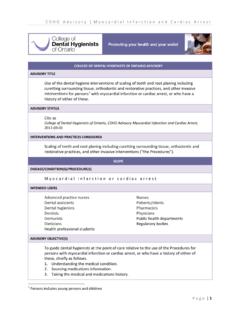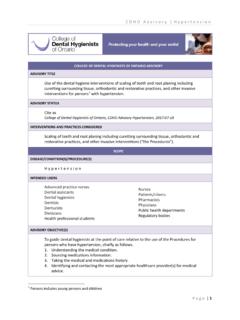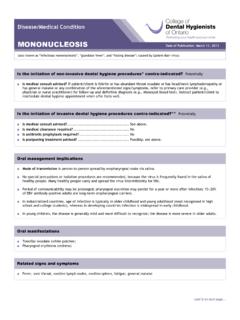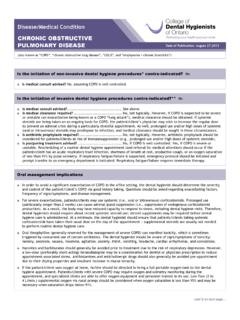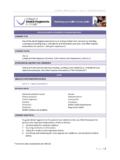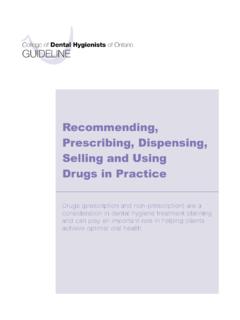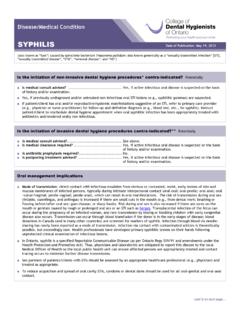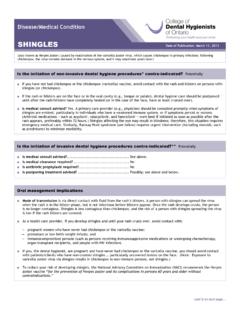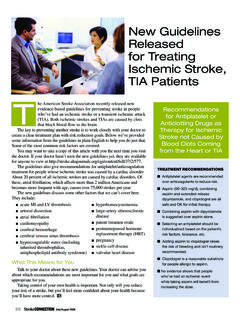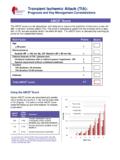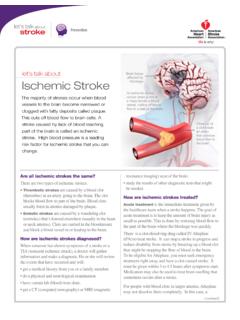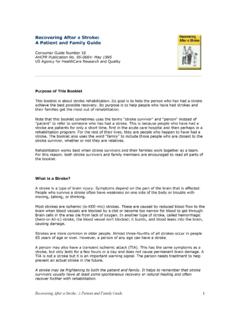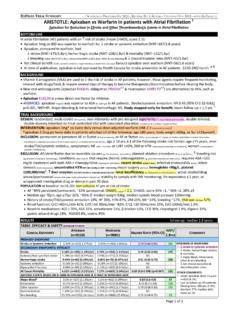Transcription of CDHO Advisory Stroke
1 cdho Advisory | Stroke Page | 1 COLLEGE OF DENTAL HYGIENISTS OF ONTARIO Advisory Advisory TITLE Use of the dental hygiene interventions of scaling of teeth and root planing including curetting surrounding tissue, orthodontic and restorative practices, and other invasive interventions for persons1 with a Stroke . Advisory STATUS Cite as College of Dental Hygienists of Ontario, cdho Advisory Stroke , 2017-06-28 INTERVENTIONS AND PRACTICES CONSIDERED Scaling of teeth and root planing including curetting surrounding tissue, orthodontic and restorative practices, and other invasive interventions ( the Procedures ). SCOPE DISEASE/CONDITION(S)/PROCEDURE(S) Stroke INTENDED USERS Advanced practice nurses Dental assistants Dental hygienists Dentists Denturists Dieticians Health professional students Nurses Patients/clients Pharmacists Physicians Public health departments Regulatory bodies Advisory OBJECTIVE(S) To guide dental hygienists at the point of care relative to the use of the Procedures for persons who have Stroke , chiefly as follows.
2 1. Understanding the medical condition. 2. Sourcing medications information. 3. Taking the medical and medications history. 4. Identifying and contacting the most appropriate healthcare provider(s) for medical advice. 1 Persons includes young persons and children cdho Advisory | Stroke Page | 2 5. Understanding and taking appropriate precautions prior to and during the Procedures proposed. 6. Deciding when and when not to proceed with the Procedures proposed. 7. Dealing with adverse events arising during the Procedures. 8. Keeping records. 9. Advising the patient/client. TARGET POPULATION Child (2 to 12 years) Adolescent (13 to 18 years) Adult (19 to 44 years) Middle Age (45 to 64 years) Aged (65 to 79 years) Aged 80 and over Male Female Parents, guardians, and family caregivers of children, young persons and adults with a Stroke .
3 MAJOR OUTCOMES CONSIDERED For persons who have Stroke : to maximize health benefits and minimize adverse effects by promoting the performance of the Procedures at the right time with the appropriate precautions, and by discouraging the performance of the Procedures at the wrong time or in the absence of appropriate precautions. RECOMMENDATIONS UNDERSTANDING THE MEDICAL CONDITION Terminology used in this Advisory Resources consulted Stroke : Heart and Stroke Stroke : MedlinePlus Stroke : National Institute of Neurological Disorders and Stroke Stroke : PubMed Health Stroke , cerebrovascular disease, cerebral infarction, cerebral hemorrhage, ischemic Stroke , cerebrovascular accident 1.
4 Is an interruption of the blood supply to any part of the brain that a. results when a blood vessel in the brain i. is blocked ii. bursts open b. denies blood and oxygen to parts of the brain c. causes sudden loss of brain function d. causes permanent damage if the flow is interrupted for more than a few seconds cdho Advisory | Stroke Page | 3 2. is a medical emergency 3. occurs chiefly as one of two types a. ischemic Stroke b. haemorrhagic Stroke . Other terminology used in this Advisory is as follows. 1. Atherosclerosis, which a. clogs arteries b. is caused by plaque, which i. is composed of cholesterol, fat and other substances ii. accumulates on the inner walls of arteries in 1.
5 The brain 2. the neck 3. the heart 4. elsewhere in the body iii. impedes blood flow iv. causes clots. 2. Blood clot, is a. a mass that occurs when blood hardens from a liquid into a solid b. called a thrombus when it forms inside a blood vessel or within the heart and remains in place c. called an embolus when it separates from a thrombus and travels from one location in the body to another, in the process is called embolism. 3. Cardiac arrest ( cdho Advisory ), which a. occurs when the heart develops an arrhythmia that causes it to cease beating b. causes death within a few minutes without medical attention c. requires emergency treatment including i.
6 Cardiopulmonary resuscitation ii. defibrillation. 4. ischemic Stroke , which a. occurs when a blood vessel supplying blood to the brain is blocked by a blood clot, which may i. form as a thrombus in an artery that is already narrow, which causes a thrombotic Stroke ii. travels as an embolus to block a smaller artery in the brain, which causes an embolic Stroke by breaking off from blood vessels in the 1. brain 2. heart 3. another part of the body b. may result from i. atherosclerosis ii. tearing in the carotid artery iii. certain medications. 5. Hemorrhagic Stroke a. occurs when a blood vessel in part of the brain becomes weak and bursts open, causing blood to leak into the brain, which damages the brain cells b.
7 May be caused by pre-existing defects in the blood vessels of the brain. cdho Advisory | Stroke Page | 4 6. Transient ischemic Attack (TIA, mini- Stroke ) a. occurs when a clot briefly blocks blood flow to the brain b. produces symptoms closely resembling those of a Stroke except that they fade or disappear within a few minutes or hours c. is an important warning sign of impending Stroke and therefore a 911 medical emergency. 7. Traumatic brain injury, acquired brain injury, damage to the brain which a. occurs after birth b. is not related to a congenital disorder or a degenerative disease. Overview of Stroke Resources consulted Statistics: Heart and Stroke Stroke Warning Signs: Heart and Stroke Foundation Stroke : Heart and Stroke Stroke : MedlinePlus Stroke : National Institute of Neurological Disorders and Stroke Stroke : PubMed Health Transient ischemic attack: PubMedHealth Stroke 1.
8 Develops as types and instances, as follows a. ischemic : about 80 percent of all strokes b. hemorrhagic: about 20 percent of all strokes c. transient ischemic attacks: 15,000 persons per year, with many believed unreported 2. occurs in Canada a. at the rate of 50,000 strokes per year b. as the third leading cause of death, which accounts for i. the deaths of 14,000 Canadians each year ii. 7 percent of all deaths in Canada c. affects i. children under the age of 19 at the rate of per 100,000 children ii. Canadians living with its consequences: 300,000 3. has various interlinked risks, risk factors and causes a. risk i. of Stroke doubles every 10 years after age 55 ii.
9 Increases by 20 percent the chances of another Stroke within two years of a previous Stroke iii. of Stroke increases fivefold relative to the general population over the two years following a transient ischemic attack iv. of brain hemorrhage is increased by substance abuse ( cdho Advisory ) including 1. alcohol 2. cocaine b. risk factors considered controllable are chiefly i. hypertension ( cdho Advisory ) which 1. is the greatest risk factor for Stroke cdho Advisory | Stroke Page | 5 2. affects one in five Canadians ii. high blood cholesterol, which 1. leads to atherosclerosis 2. is major risk factor for Stroke 3. if lowered overall leads to marked reduction in the risk of Stroke iii.
10 Atrial fibrillation, which 1. is the commonest type of cardiac arrhythmia 2. increases risk of Stroke between three and five times 3. is thought to account for 15 percent of ischemic strokes 4. increases with age: after age 60, 30 percent of strokes are attributed to it iv. diabetes ( cdho Advisory ), especially when poorly controlled, increases the risk of 1. hypertension 2. atherosclerosis 3. Stroke v. bleeding disorders ( cdho Advisory ) vi. obesity and overweight, major risk factors for heart disease and Stroke vii. excessive alcohol consumption, alcohol consumption beyond certain limits is considered a risk factor viii. head injury resulting in brain injury ix.

